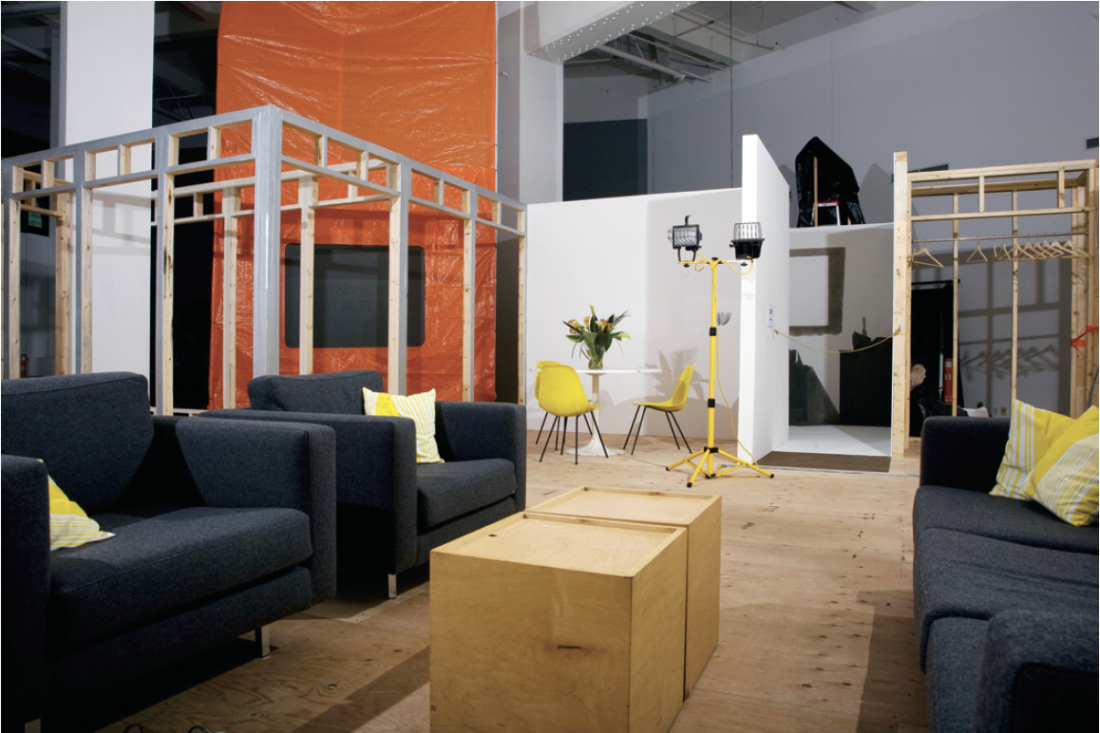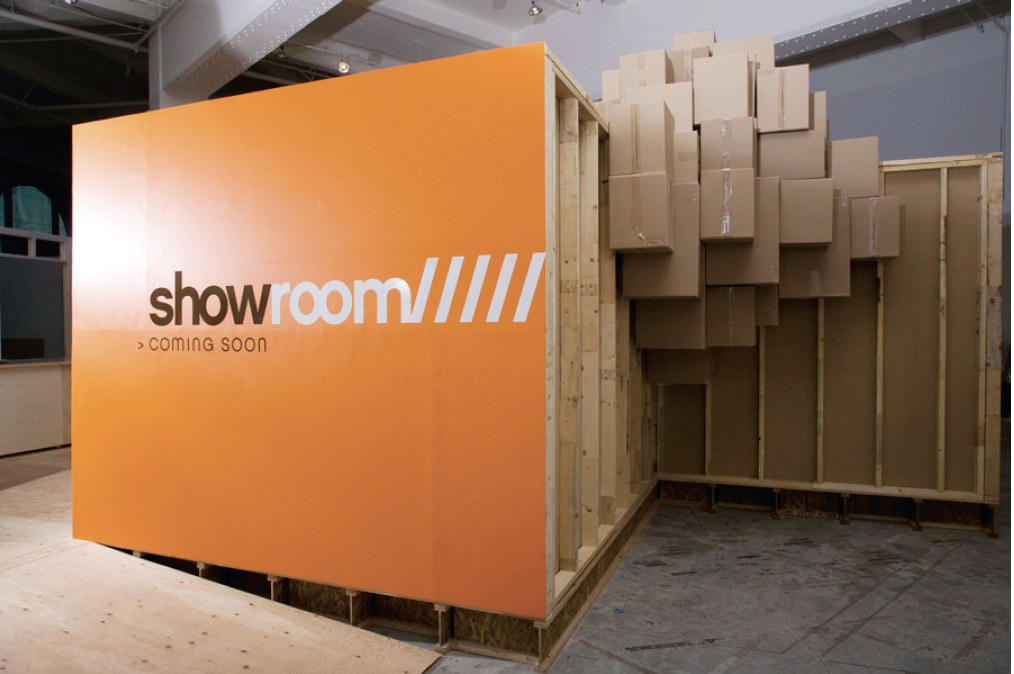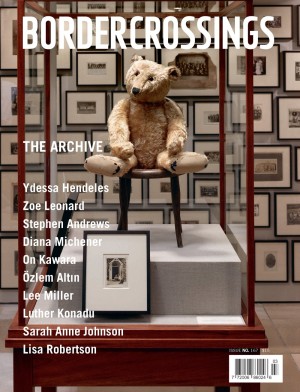“Showroom”
“Showroom” was an ambitious exhibition of contextual artworks and a series of events framed within a gallery space, mocked up to look like a condo showroom. From the street, the exhibition, at Centre A’s short-term lease space in the heart of the Gastown redevelopment zone in Vancouver, looked for all intents and purposes like a real condo showroom. It was only after entering the space and looking around a little that the ruse became apparent. The showroom was unfinished, with exposed plywood and stud walls, traffic pylons warning of unfinished edges, and fluorescent orange plastic fencing guarding trees waiting to be planted. Although a little overstated, that kind of incompletion isn’t uncommon in the early stages of condo development. But there were more obvious clues: the entire showroom area elevated like a stage, empty picture frames over the modernist sofas, an oversized plywood round table so large it left no space for chairs in the alcove it occupied, a model room comprising only the shadows of the furniture you would have expected to find in it, tarps and scaffolding improvising a Times Square-ish theatre for promotional videos, a Habitat-like agglomeration of cardboard packing boxes perched precariously on one corner of yet-to-be-drywalled stud walls, a business centre with computer workstation isolated from the main platform by a walkway and mysteriously glassed in.

Installation view at Centre A, Vancouver, 2008. Photo: William Ting.
The raised showroom floor was literally a platform or stage for the exhibition of site-specific artworks that played with the vernacular of commercial promotional spaces. Though reminiscent of Venturi’s early postmodernism—some of the individual pieces struggling with their autonomous status as art in relation to their context—it was the overall impression of the whole that seemed more important, building the effect of an active unsettling or displacement of the meaning of condo showroom.
“Showroom” was also the platform for an ambitious series of events—lectures, presentations, forums, even a silent auction, all of which approached the topic of urban design and development, with titles like “Fearless City,” “Cube Living,” “On Making Vancouver,” “Live/Work Where?” “On Architecture,” “What is Public?” and “In Situ Space?”

One of 13 public forums that took place during the exhibition “Showroom,” Centre A, Vancouver, 2008. Photo: Hank Bull.
Both as art—a curated exhibition— and as a curriculum— a forum about urban planning—“Showroom” confounded expectations. And that would seem to be precisely the point, as Patrick Foong Chan explains in his essay “Interdisciplinarity and Coming Communities” published in the program guide for the show. Weaving together various threads of philosophy—the warp of destabilizing indeterminacy (Foucault) intertwining with the weft of unknowable potentiality (Giorgio Agamben, Jean-Luc Nancy)—to create a fabric to carry into the present the idea that hope can only arise out of the state of social freedom (Spinoza), Chan argues convincingly that change is what is most essential for a cityscape to be vital. The city is, and must be, in a perpetual state of becoming. He illustrates his point with well-chosen examples: public parks intended for recreation are used by activists, corner storefronts become galleries, unusual backyard architectures challenge conventions, laneways saturated with graffiti change from throughways to destinations. These environments/architectures force us to suspend our judgments of good and bad, proper and improper, legal and illegal. For the designer, artist, planner, architect, these spaces are not merely demonstrations of a particular theory, they embody theory; they show that the meaning of space is transitory, defined in the moment, the result of a constant working with/working out of conflicts and challenges.

Michelle Allard, Showroom Assemblage, 2008, from “Moving Kits” series, cardboard boxes, packing tape. Photo: William Ting.
“Showroom” was astutely and resolutely conceptualized in relation to the Olympian progressions of 21st-century global urbanism, locally manifested in Vancouver’s real estate boom. More particularly, it engaged fearlessly with the immediate context of Vancouver’s east end, where development is surging against invisible levies that contain Canada’s poorest postal code. Here, gentrification is thrown into stark contrast against poverty. Design and urban planning are abraded by the inarticulate, uneducated, nonconforming and unpredictable. The nature of economically driven social engineering begins to show through, appearing as bereft of purpose as the people who sleep in its doorways.
Perfect in its imperfection, finished in its lack of finish, “Showroom” stood half in the glow of condo fever and half in the shadow of dereliction, simultaneously evoking aesthetic delight and critical concern. It took an active position: embodying commitment to openness, to uncertainty, turning the institutions of the gallery and of art outward to purposively give hope space. ■
“Showroom,” curated by Kristina Lee Podesva and Inge Roecker, was exhibited at Centre A in Vancouver from June 6 to 12, 2008.
Robert Labossiere is a visual artist and the Managing Editor of YYZBOOKS, the publishing program of the artist-run centre YYZ. Originally from Winnipeg, he lives and works in Toronto.

